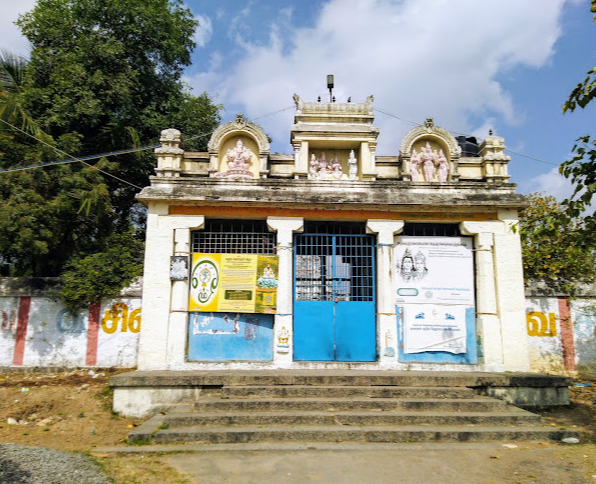Origin/History :-
The name “Killi” was commonly used among the Chozha Kings, with historical figures like Killivalavan and Nedungkilli mentioned in Sangam literature. It is believed that this place might have originally been called Killiyanallur, which gradually evolved into the present name, Kiliyanur.
The loose sculptures of Jyeshta Devi and Chandikeswarar, found on the backside of the temple, date back to the Pallava period, suggesting that the temple was likely constructed during the Pallava era and later reconstructed as a stone temple during the Chozha period.
Inscriptions on the sanctum sanctorum walls indicate that this place was called Jayankonda Chozhamandaalathu Oyma Nadu Brahmadeya Kiliyanallur. During the Chozha Kings’ rule, the region was part of Keralanthaga Chaturvedi Mangalam and Vijaya Rajendra Valanadu. Lord Shiva was referred to as Thiruvagniswaram Udayar. The 9th-century inscriptions record donations made for regular poojas, the burning of perpetual lamps, and offering Naivedyam. One of the Chozha Kings (name damaged) established an endowment, though further details are unclear.
The inscription from the 10th reign year of Chozha King Koparakesari (Parantaka I) mentions the endowment of special Naivedyam with 4 nali rice offered during worship on Amavasya and Sankranti day by Parasaran Thayan Sathan.
In Rajendra Chozha's 3rd reign year, an inscription records the donation of a perpetual lamp by a Brahmin lady, who also gifted 90 goats to the temple.
An inscription from the Kulothunga Chozha period notes the endowment for special poojas to Pichadanar (Bhikshatana) and the burning of perpetual lamps.
A damaged inscription from Vikrama Chozha's reign starts with his Mei Keerthi as "Poomathu....." and mentions a land gift by the villagers of Kiliyanur alias Ulakuyyakonda Chozha Chaturvedi Mangalam.
Rajathi Rajan’s 28th reign year inscription, beginning with his Mei Keerthi as "Thingalertharu...", records that land was sold for Naivedyam for Thiruvagniswaramudayar by the Keralanthaka Chaturvedi Mangalam village sabha. A 29th reign year inscription also records another land sale for the same purpose.
An inscription from Kulothunga Chozha’s 3rd reign year mentions that the Ulakuyyavanda Chozha Chaturvedi Mangalam sabha, also known as Kiliyanur, exempted taxes on some lands. The inscription also refers to the capital deposited in the treasury and the deity Pichadevar (Pichadanar).
A Vijayanagara Period inscription from 1372 CE, by Mallikarjuvarayar, records the rectification of the water regulator of the Eri (tank) and repairs to the Eri damaged by a cyclone. This inscription, located near the Madapalli, refers to the place as Kilivalanallur.
Thus, the temple has a rich history, with contributions from various Chozha kings, as well as later mentions in the Vijayanagara period. The temple was likely constructed during the Pallava period and further developed during the Chozha period, with numerous inscriptions detailing endowments, offerings, and renovations over the centuries.
Puranic Significance :-
- Sage Kalava Maharishi’s Visit to the Temple:
It is said that Sage Kalava Maharishi visited this place and stayed here for a long time with his two daughters, who were suffering from critical illnesses. After praying to Lord Shiva, their devotion impressed the deity, and Lord Shiva blessed the daughters, curing them of their ailments.
- Agastheeshwarar:
The presiding deity of the temple, Agastheeshwarar, is believed to have been installed and worshipped by Sage Agasthiyar. As a result, the lord is named Agastheeshwarar.
- Nandi Devar Worships Ambal During Maha Shivaratri:
According to tradition, Nandi Devar, the sacred bull and mount of Lord Shiva, worships Goddess Akilandeswari on Maha Shivaratri. Inscriptions in the temple mention this act of devotion.
- Worship by Various Devotees:
The Moolavar (main deity) was installed by Sage Agasthiyar and has been worshipped by several prominent figures, including Sage Sukar, Adhishesan, and Kalava Maharishi.
- Sage Sukhabrahmma’s Worship:
It is believed that Sage Sukhabrahmma, who is depicted with a parrot face, visited the temple to seek relief from stomach ailments. In honor of this event, the village was named Kiliyanur (after "Kili," the Tamil word for parrot).
- Adhiseshan Worshipped Lord Shiva Here:
Adhiseshan, the serpent who serves as the resting place for Lord Vishnu, is also said to have worshipped Lord Shiva at this temple. Therefore, this temple is regarded as a Rahu Kethu Parihara Sthalam (a place to seek relief from the doshas of Rahu and Kethu).
- Connection to Early Cholas:
The name "Kili" is associated with the Chola Kings, such as Nedunkilli and Killivalavan, suggesting a historical connection to the Chola dynasty.
